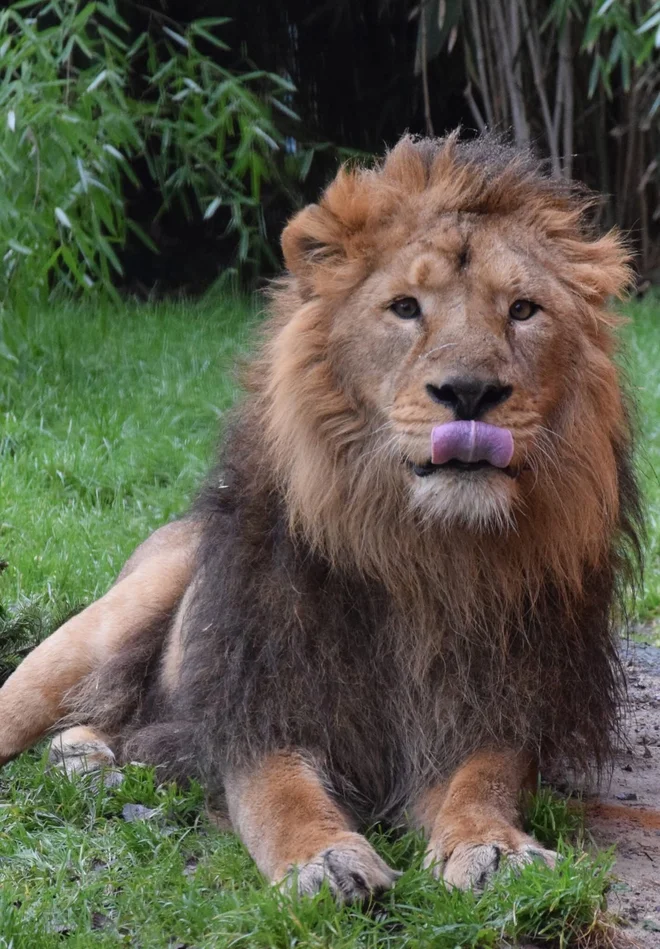A furry Asian beauty arrived in Ljubljana’s zoo

A new resident was rejoiced at the Ljubljana Zoo. At the end of April, an Asian lion, one of the most endangered lions in the world, arrived. A magnificent animal came to Slovenia as part of the international program preservation program European Association of zoos and aquariums – Eaza, and, as ZOO Ljubljana wrote in a post -public basis, will be an important ambassador for raising awareness of the extinction of large beasts. “His arrival is a new chapter in our efforts to preserve biodiversity and an invaluable opportunity for visitors to get to know the Indian king of an animal who is in the nature It almost disappeared, ”they wrote.
A nine -year -old male named Raman was born on 25 in January 2016 at the Planckendael Belgium Zoo. « His name is inspired by optimism, because in Hindi and Sanskrit » Raman « often means » pleasant « or » cute « or » consecrated « or » celebrated « and is also a name associated with God Rama, one of the important deities in Hinduism. At the age of two, Raman from Belgium was moved to ZOO Maubeuge, France, where he recently lost an older roommate, much like our 16-year-old Life, « said ZOO Ljubljana.
Raman is very good at the basics of veterinary training, which will make it much easier for caretakers to work with. “At around 4pm, the carrier brought the highly anticipated resident to ZOO Ljubljana, where his new and very dedicated caretakers were waiting for him. The transport box with a new member, which was as much as 173 kg, was transferred to interior space. Raman, a little tired of driving, did not immediately decide to leave the transport box, but with some tricks of our experienced caretakers, he just stepped into his new home. Only then could we fully see our new, beautiful and mighty animals, « they are impressed by the new resident at ZOO Ljubljana.
A nine -year -old male named Raman was born on 25 in January 2016 at the Planckendael Belgium Zoo. Photo: Zoo Ljubljana
The lion probably has a distinctly friendly and youthful expression and wonderful teeth. Visitors will certainly also notice his more pronounced abdomen, which is one of the major noticeable distinctive characters between Asian and African lions. « But we were not only us – with all the curiosity of his future fence, his future roommate Zivana was also observed from the hill of the neighboring fence, » they added.
Raman will now take some time to get used to the new environment and society, so in the next few days it will first be on display at the indoor viewers, and towards the end of the month in the outside.
Extremely at -risk Asian lions
Asian lions (Panthera Leo Persica) are one of the most endangered lions in the world. They once inhabited extensive areas from southeastern Europe and the Middle East to East India, which covered thousands of miles. Today, in nature, in a single isolated population, there are only about 600 to 700 specimens in the GIR National Park, in the federal State of Gujarat, West India.
This reduced area is now their only natural habitat, making it extremely vulnerable to threats such as diseases, natural disasters and potential conflicts with people due to the lack of genetic diversity. Due to the limited space, the lions cannot retreat from the dangers or spread to new areas, which threatens their survival and the long -term growth of the population. Nevertheless, efforts to preserve them are successful – Indian authorities carry out strict protection of the area, programs to prevent conflicts between the left and the local population and are looking for additional suitable locations for their settlement.

The Asian lion is a symbol of a successful but still very « fragile » nature conservation effort. Photo: Zoo Ljubljana
The Asian lion is a symbol of a successful but still very « fragile » nature conservation effort. Despite all the efforts to preserve, the species also faces the challenges of a small genetic pool of this subspecies. Asian lions, which live in nature and in zoos, originate from a very small number of ancestors, which increases the risk of mating in kinship and occasionally leads to health problems associated with low genetic diversity.
Role of zoos in preserving Asian lions
In 1994, a European breeding EX-Situ program of endangered species (EEP) and later a pedigree book was introduced within the European Federation of Zoos and Aquariums (Eaza). By 2005, there were 80 Asian lions in the European breeding program, but today more than 100. These are the only Asian lions that live outside India and represent an important backup population in the event of a loss of the last major risk wild population in India.
Some major zoos, in collaboration with partners in India, build a permanent infrastructure to protect Asian lions, pay for dedicated and trained forest guards, support the system of monitoring animals to obtain scientific data on what is happening in the protected area, which would help to identify the wild population of Asian lions in a timely manner. Local community education is also crucial about the importance of lion conservation.
Asian lions in zoos, including Ljubljana, which has been bred since 2019, are an important part of the breeding program in order to strengthen and solve a major endangered wild population in GIR, which once resoluted all the way to North Africa, they added to ZOO Ljubljana.







/s3/static.nrc.nl/images/gn4/stripped/data132213445-78519d.jpg|https://images.nrc.nl/PKPMzxQP_V__Ni-ALl99ZvJPD8g=/1920x/filters:no_upscale()/s3/static.nrc.nl/images/gn4/stripped/data132213445-78519d.jpg|https://images.nrc.nl/PtnkkFYqZD1Bt_qsd_3QgKqTgPY=/5760x/filters:no_upscale()/s3/static.nrc.nl/images/gn4/stripped/data132213445-78519d.jpg)
